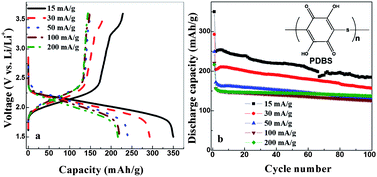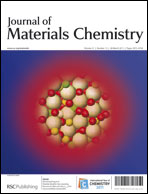An organic cathode material, poly(2,5-dihydroxyl-1,4-benzoquinonyl sulfide) (PDBS), has been synthesized and assessed as a cathode material for lithium ion batteries. The prepared polymer material is characterized by 13C solid state NMR, FTIR, XPS and elemental analysis techniques. The 13C solid state NMR, FTIR and XPS results indicate that the chlorine of chloranilic acid (CLA) is successfully substituted by sulfur after a sulfurization reaction. Elemental analysis shows that the prepared polymer is mainly composed of dimer and trimer. The electrochemical measurements show that the initial discharge capacity of PDBS is up to 350 mAh g−1, and 184 mAh g−1 still remains after 100 cycles at the current density of 15 mA g−1 in the voltage range of 1.5–3.6 V. The PDBS also shows high cycling stability, good rate capability and discharge/charge coulombic efficiency of higher than 98%, except for in the initial cycles. The good cycling stabilities and the high coulombic efficiency of the material are ascribed to the stable thioether bonds for stabilizing the framework of the polymer and the highly reversible carbonyl groups for energy storage.

You have access to this article
 Please wait while we load your content...
Something went wrong. Try again?
Please wait while we load your content...
Something went wrong. Try again?


 Please wait while we load your content...
Please wait while we load your content...